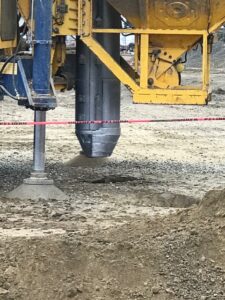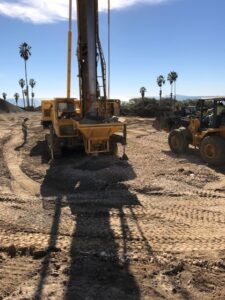
In the world of agriculture, environmental science, and geotechnical engineering, one term holds paramount significance – soil moisture content. At G3SoilWorks, we understand that grasping the intricacies of soil moisture measurement and employing effective soil moisture measurement methods is the key to unlocking the potential of this critical resource. Keep reading to learn more about the importance of soil moisture content.
Soil moisture content, often expressed as a percentage, represents the ratio of the water present in a given soil sample to the dry weight of that sample. It signifies the soil’s ability to retain and supply water to plants and ecosystems.
Soil moisture content plays a vital role in agriculture, where it influences crop growth and yield. It’s also a key player in environmental science, affecting the water cycle, climate, and ecosystem health. In geotechnical engineering, soil moisture content impacts stability and construction projects.
In the realm of agriculture, the importance of soil moisture content cannot be overstated. It influences every facet of plant growth and agricultural productivity.
Adequate soil moisture levels are essential for optimal plant growth. Inadequate moisture can lead to stunted growth, reduced crop yield, and even crop failure.
Soil moisture data guides irrigation decisions, helping farmers apply water precisely when and where it’s needed, conserving water resources, and reducing the risk of overwatering.
Soil moisture affects the availability and uptake of essential nutrients by plants. Proper moisture levels ensure nutrients are accessible to plant roots, enhancing nutrient use efficiency.

In the realm of environmental science, understanding soil moisture content is crucial for comprehending a range of crucial processes and ecosystems.
Soil moisture is an integral part of the water cycle, affecting infiltration, runoff, and groundwater recharge.
Changes in soil moisture content impact local climate and weather patterns. Wet soils can increase humidity, affecting temperature and precipitation.
Soil moisture levels influence vegetation health and, consequently, biodiversity. Healthy ecosystems depend on the right balance of moisture for plant growth and wildlife habitat.
In the domain of geotechnical engineering, the importance of soil moisture content cannot be ignored, as it can make or break construction projects.
The moisture content of soil directly influences its stability. Excessive moisture can lead to landslides, while overly dry soil can result in settling and structural issues.
Soil moisture data is crucial for designing foundations and assessing construction site conditions, ensuring the safety and durability of structures.
Geotechnical engineers rely on soil moisture information for accurate site assessments and to make informed decisions about soil stabilization methods.
Accurately measuring soil moisture content is essential for effective management. Several methods and tools are available.
Common methods include the gravimetric method (weighing soil samples), Time Domain Reflectometry (TDR), and capacitance sensors that use electrical properties to estimate moisture levels.
Each method has its advantages and limitations, such as precision, cost, and depth of measurement.
Regular monitoring is essential to maintain optimal soil moisture levels and prevent issues like water stress or over-saturation.
Effective soil moisture management is a multifaceted endeavor that encompasses a combination of techniques and practices. To ensure your soil retains the right amount of moisture for healthy plant growth and environmental sustainability, consider the following strategies:
Irrigation Scheduling: Properly timed and controlled irrigation is crucial for maintaining optimal soil moisture levels. Utilize weather data, soil moisture sensors, and automated irrigation systems to tailor your watering schedule to the specific needs of your plants. This approach conserves water and minimizes the risk of overwatering.
Applying mulch to the soil surface helps conserve moisture by reducing evaporation and inhibiting weed growth. Organic mulches, such as wood chips or straw, can also improve soil structure over time as they break down.
Enhance your soil’s water retention and drainage capabilities through appropriate soil amendments. For example, adding organic matter like compost can improve water-holding capacity, while incorporating sand or perlite can enhance drainage in clay-heavy soils.
Adequate Drainage: Ensuring that your soil has proper drainage is essential to prevent waterlogging. Poorly drained soil can suffocate plant roots and promote the growth of harmful pathogens. Implementing raised beds, installing drainage systems, or amending the soil with coarse materials like gravel can improve drainage.
Soil structure plays a vital role in moisture management. A well-structured soil with good aggregation allows water to infiltrate and be stored efficiently. Avoid compaction by limiting heavy machinery on your soil and practicing no-till farming techniques to preserve soil structure.
Sensors and Data-Driven Approaches: Embrace modern technology by installing soil moisture sensors in your fields. These sensors provide real-time data on soil moisture levels at various depths, allowing you to make data-informed decisions about irrigation and other moisture management practices. Data-driven approaches enable precision management, helping you optimize water use and increase efficiency.
Implement automated irrigation systems that can be controlled remotely based on soil moisture data. These systems can adjust watering schedules, duration, and intensity, ensuring that your crops receive the precise amount of moisture they need.
Utilize mobile apps and software tools that integrate soil moisture data with weather forecasts, helping you make timely decisions regarding irrigation and other moisture-related practices. These tools can also provide historical data for trend analysis and planning.
By incorporating these strategies and embracing the role of technology in soil moisture management, you can maintain an ideal moisture balance in your soil. This not only promotes healthier plant growth and higher crop yields but also contributes to water conservation and sustainable land management practices. Proper soil moisture management is a cornerstone of success in agriculture and environmental stewardship, and it is essential for achieving your goals while preserving our natural resources.

G3SoilWorks has some of the most experienced geologic engineers in Southern California. Our principals are veterans, with over 100 years in geotechnical, environmental, and engineering geologic consulting experience throughout the southwest and western United States.
In Costa Mesa, CA, and beyond, recognizing the importance of soil moisture content is the first step toward sustainable agriculture, environmental conservation, and safe engineering projects. By harnessing the power of knowledge and technology, we can ensure that our soil remains a source of life, nourishing our fields, protecting our environment, and supporting our infrastructure.
At G3SoilWorks, we are committed to helping you unlock the full potential of soil moisture content through advanced soil moisture measurement methods and data-driven solutions. Call us at +1 714-668-5600 for more information.
FAQ 1: How can I improve soil moisture management in my garden?
Answer: To enhance soil moisture management in your garden, consider the following:
FAQ 2: How can technology help with soil moisture management?
Answer: Technology plays a significant role in effective soil moisture management. Here’s how:
FAQ 3: What are the benefits of proper soil drainage and structure for soil moisture management?
Answer: Proper soil drainage and structure are essential for effective soil moisture management. Benefits include:
Follow, engage, learn. Stop by our blog to see what’s happening at G3SoilWorks.
G3Soilworks – a full service geotechnical/ engineering geologic consulting firm serving clients since 2009 and delivering expert solutions with our highly experienced team and specialized consultants.
G3SoilWorks
350 Fischer Avenue Costa Mesa, CA 92626
Tel. 714.668.5600
E. info@g3soilworks.com